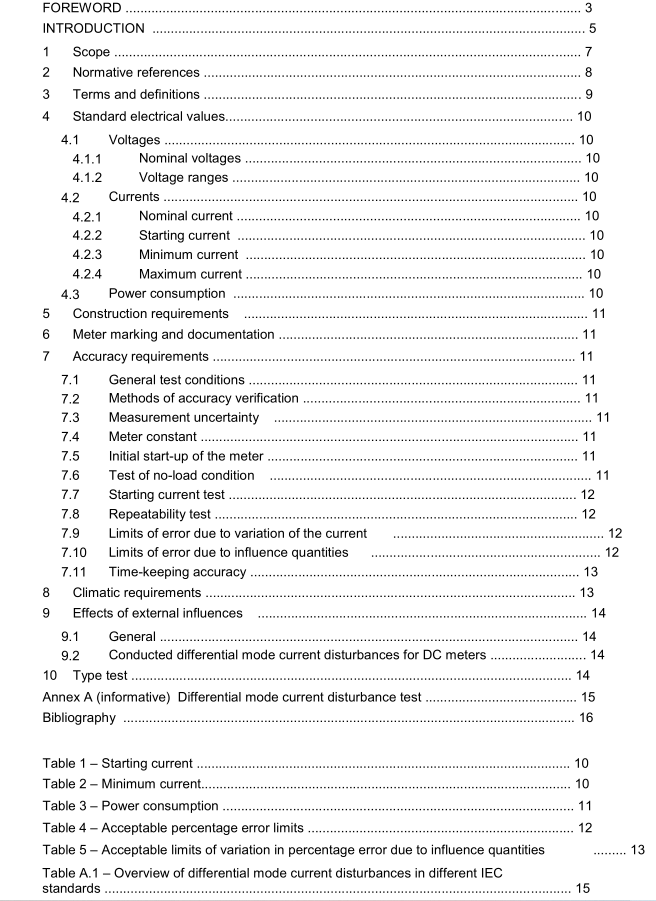IEC 62053-41 pdf – Electricity metering equipment – Particular requirements – Part 41: Static meters for DC energy (classes 0,5 and 1)

IEC 62053-41 pdf – Electricity metering equipment – Particular requirements – Part 41: Static meters for DC energy (classes 0,5 and 1)
1 Scope
This part of lEC 62053 applies only to static watt-hour meters of accuracy classes 0,5 and 1 forthe measurement of DC electrical energy in DC systems, and it applies to their type tests only.
NOTE 1 For other general requirements, such as safety,dependability,etc.,see the relevant parts of IEC 62052 orEC 62059.
This document applies to electricity metering equipment designed to:
.measure and control electrical energy on electrical networks with two poles where one of
the poles is connected to earth and with voltage up to 1 500 v DC;
NOTE 2There are DC networks with other configurations or with more than 2 poles (fr example networks withearth and both a positive and a negative pole)-
.have all functional elements,including add-on modules,enclosed in, or forming a single
meter case with the exception of indicating displays;
operate with integrated or detached indicating displays, or without an indicating display,be installed in a specified matching socket or rack;
optionally, provide additional functions other than those for measurement of electricalenergy.
The electricity metering equipment covered by this document may be used for measuring DCelectrical energy in the following, or similar, application areas:
. in EV (electrical vehicle) charging stations or in EV charging infrastructures, if themeasurement is placed on the DC side;
.in information technology (IT) server farms;
– in DC supply points for communication equipment;
.in low voltage DC networks for residential or commercial areas, if the measurement is placed
on the DC side;
. in solar PV (photovoltaic) systems where DC power generation is measured;. in DC supply points for public transport networks (e.g. trolleybus, etc.).
Meters designed for operation with low power instrument transformers,LPlTs as defined in the
IEC 61869 series,may be tested for compliance with this document only if such meters andtheir LPIlTs are tested together and meet the requirements for directly connected meters.
NOTE 3 Modern electricity meters typically contain additional functions such as measurement of voltage magnitude,current magnitude,power,etc:; measurermentof power quality parameters;load control functions; delivery,time,test,accountng,recording functions; data communication interfaces and associated data security functions. Therelevant standards for these functions may apply in addition to the requirements of this document. However,therequirements for such functions are outsidethe scope of this document.
This document does not apply to:
.meters for which the voltage between the two poles, where one of the poles is connected to
earth, exceeds 1 500 vDC;
meters to be used in networks other than with two poles in which one of the poles isconnected to earth;
meters intended for connection with low power instrument transformers (LPITs as definedin the lEC 61869 series) when tested without such transformers;
metering systems comprising multiple devices physically(except LPITs) remote from oneanother;
portable meters;
NOTE 4Portable meters are meters that are not permanently connected..meters used in rolling stock, vehicles, ships and airplanes;. laboratory and meter test equipment;
reference standard meters;
· data interfaces to the register of the meter;
.matching sockets or racks used for installation of electricity metering equipment;.any additional functions provided in electrical energy meters.
This document does not cover measures for detection and prevention of fraudulent attempts tocompromise a meter’s performance (tampering).
NOTE 5 Nevertheless,specific tampering detection and prevention requirements,and test methods,as relevant fora particular market are subject to agreement between the manufacturer and the purchaser.
NOTE 6 Specifying requirements and test methods for fraud detection and prevention would be counterproductive,as such specifications would provide guidance for potential fraudsters.
NOTE 7 There are many methods of tampering with meters reported from various markets;designing meters todetect and prevent all kinds of tampering would lead to unjustified increase in costs of meter design,verication andvalidation.
NOTE 8 Billing systems,such as,smart metering systems, are capable of detecting irregular consumption pattemsand irregular network losses which enable discovery’of suspected meter tampering.
NOTE 9 This document does not specify emission requirements, these are specified in IEC 62052-11:2020,9.3.14NOTE 10 DC meters for rolling stock are covered by other lEC standards, e.g.,from TC 9 for rallway applications:IEC 62888-1:2018, IEC 62888-2:2018,IEC 62888-3:2018, IEC 62888-4:2018,iEC 62888-5:2018.
2Normative references
The following documents are referred to in the text in such a way that some or all of their contentconstitutes requirements of this document. For dated references, only the edition cited applies.
For undated’ references,the latestedition of the referenced document (including anyamendments) applies.
IEC 61000-4-19:2014, Electromagnetic compatibility(EMC) – Part 4-19: Testingandmeasurement techniques – Test for immunity to conducted, differential mode disturbances and
signalling in the frequency range 2 kHz to 150 kHz at a.c. power ports









